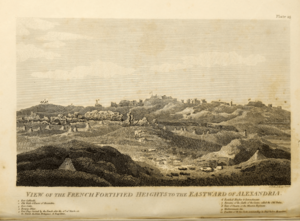Siege of Alexandria (1801) facts for kids
Quick facts for kids Siege of Alexandria |
|||||||
|---|---|---|---|---|---|---|---|
| Part of the French Campaign in Egypt and Syria during the War of the Second Coalition | |||||||
 French fortified heights to the eastern side of Alexandria |
|||||||
|
|||||||
| Belligerents | |||||||
| Commanders and leaders | |||||||
| Strength | |||||||
| 13,000 | 20,000 | ||||||
| Casualties and losses | |||||||
| 10,000 captured 2,000 to disease 9 warships captured |
Low | ||||||
The Siege of Alexandria was a major military event that happened from August 17 to September 2, 1801. It was part of the French Revolutionary Wars. This siege was the very last battle of the French campaign in Egypt and Syria (1798–1801). French forces had been in control of Alexandria, a big port city in northern Egypt, since July 2, 1798. The French soldiers there finally gave up on September 2, 1801.
Contents
Why the Siege Happened
Before the siege, British and French forces fought at Canope on March 21, 1801. The French, led by General Menou, lost this battle. They felt defeated and went back to Alexandria.
After the British commander, Abercrombie, died, John Hely-Hutchinson took over. He decided to surround Alexandria to trap Menou and his troops.
Hutchinson left General Coote with 6,000 soldiers. He also sent some troops to capture the town of Rosetta. Then, Hutchinson moved towards Cairo, the capital, and reached it in mid-June. With help from a large Turkish army, Hutchinson surrounded Cairo. On June 27, the French soldiers there, about 13,000 strong, were outnumbered and outgunned. They surrendered. General John Moore then helped them travel to the coast.
The Siege of Alexandria
With Cairo now under control, Hutchinson focused on Alexandria. He had many battalions (groups of soldiers). While some British troops pretended to attack from the east, General Coote and his brigades landed on August 16 to the west. They faced strong resistance from the French soldiers defending Fort Marabout. The 54th Regiment of Foot eventually fought their way into the fort.
Both sides tried to attack, but the French soldiers were stuck inside the city. They started running out of food, and many got sick. They became very discouraged. General Menou knew his situation was hopeless. On August 26, he asked to discuss terms for surrender. The agreement they reached is known as the Capitulation of Alexandria.
What Happened After
By September 2, about 10,000 French soldiers surrendered. They were allowed to keep their personal weapons and belongings. They could also return to France on British ships. However, all French ships and cannons in Alexandria were given to the British.
Some of the French warships captured by the British included the frigates Égyptienne (50 guns) and Régénérée (40 guns). The ex-Venetian frigate Léoben (26 guns) also went to Britain. Other ships, like the French frigate Justice (44 guns) and some ex-Venetian and ex-Turkish ships, were given to the Turkish forces.
Historians say that the French soldiers felt forgotten by their government. They slowly lost their high spirits and discipline. Many refused to promise loyalty to France again. A doctor named Baron Dominique-Jean Larrey wrote in his memories that eating horse meat helped the French soldiers fight against a disease called scurvy. This later led to horse meat becoming a food in France.
The Rosetta Stone's Journey
After the French surrendered, there was an argument about what would happen to the amazing discoveries they made in Egypt. One of the most important finds was the Rosetta Stone. French scientists from the Institut d'Égypte had found it in July 1799. General Menou didn't want to give it up, saying it belonged to the institute.
Exactly how the stone ended up with the British is still debated. Colonel Tomkyns Hilgrove Turner, who took the stone to Britain, later said he personally took it from Menou. He claimed he carried it away on a gun carriage. Turner brought the stone to Britain on the ship Egyptienne, arriving in February 1802. On March 11, it was shown to the Society of Antiquaries of London. Later, it was moved to the British Museum, where it is still kept today.
On the stone itself, white writing says "Captured in Egypt by the British Army in 1801" on one side. On the other side, it says "Presented by King George III".
Images for kids
See also
- French Campaign in Egypt and Syria


